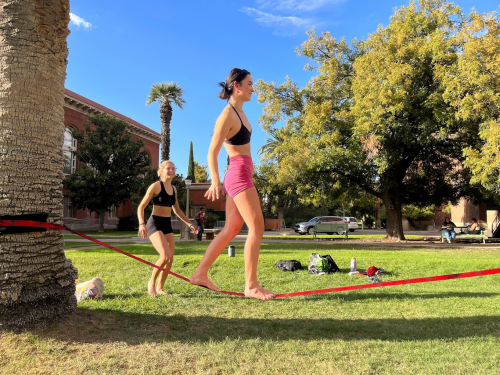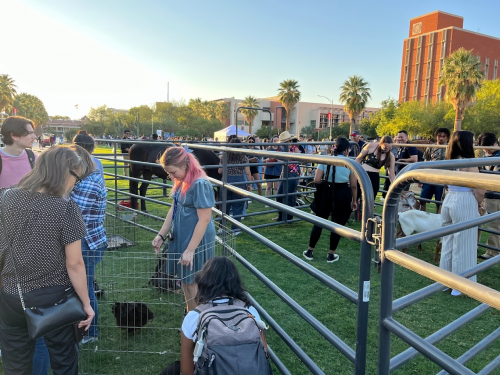
Riley Brown, El Inde Arizona
Sand, dirt and rocks covered in prickly plants including the iconic saguaro or the jumping cholla.
A place that can hit triple digits in October.
Tucson is known for its heat and Sonoran Desert landscape.
It is a place where besides for golf courses, lush grass is a rarity until you enter the University of Arizona campus.
The campus is covered in manicured fluffy green grass. Water is not plentiful in Arizona so 95% of the grass is watered with reclaimed water – about 70 million gallons last year alone – said Chris Kopach, associate vice president of Facilities Management.
The university has been using reclaimed water for the past 15 years, Kopach said. It’s the treated sewage water used for vegetation and refilling the aquifer.
Although using reclaimed water tackles parts of the negative effects lawns can have on the environment, it does not tackle them all. According to a study in 2011 by the Ecological Society of America, grass lawns in the Sonoran Desert may be taking a toll on native animal species.
“When you look at lawns compared to forest, yes they are different from the forest, but they are not so strikingly different; it’s all green.” said Susannah Lerman, a research ecologist with the U.S. Forest Service and one of the researchers who conducted this study.
“In Tucson it is a totally different story because when you look out into the desert, unless it is right after the rains and there are a lot of wildflowers that have sprouted up, it is not green,” she said. “So the difference in terms of that landscaping is so much more striking in the Southwest and the Sonoran Desert.”
Which may cause native species to avoid these areas.
Lerman and her team compared bird populations in Phoenix yards that were grass versus desert landscapes.
In the grass yards, researchers found that non-native species were more common, including great-tailed grackles, house sparrows and European starlings. In the desert landscaped yards, native species including cactus wrens, greater roadrunners and curve billed thrashers were much more common.
“These are birds you can’t see in other parts of the world because they are so focused on that kind of vegetation,” said Lerman.
Grass is also not ideal for pollinators since there is nothing to pollinate. Lerman pointed to her 2018 research in Massachusetts that found that mowing lawns less may help pollinators. This is because it allows for flower producing seeds in the seed bank to grow. Less mowing also produces less pollution since the lawnmowers release carbon dioxide into the atmosphere.
On the UA campus these large patches of grass are used by students to relax, study, walk their dogs and have picnics. The campus also has large grassy fields for UA sports including baseball, softball and football.
UA junior and Animal Science major, Jocelyn Tijerina, was using the lawn to slackline – think tightrope walking only on a slackline that’s close to the ground.
“Sometimes you just need to walk around in grass, reconnect to your roots,” said Tijerina, who was barefoot in the grass in front of the Arizona State Museum on a Monday in early October as she taught her friend, Dezi Rachels, how to slackline.

“I always was in nature as a kid, so I definitely feel like it is important to me to have (grass) or to have access to it at least,” she added.
“I just started fostering a dog so it has been more often than I used to, so I’d say probably three times a week I come out whether it’s on the mall or out here,” said Rachels who is a UA sophomore majoring in Neuroscience and Cognitive Science along with Gender and Women’s Studies.
Along the lush expanse of lawn at the UA Mall, students toss Frisbees and footballs while others simply plop down on a blanket in the grass to study or tan. The mall is often used for events, some of which include dog fashion shows, petting zoos and movie nights that are put together by UA students and staff.

Although Lerman studies the negative effects of grass, she understands that it can be useful for gathering and recreation that she sees as a societal need.
“The question is: how much lawn is necessary to be able to fill some of these other societal needs?” Lerman said.
El Inde Arizona is a news service of the University of Arizona School of Journalism.
